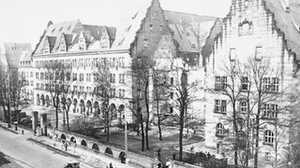Simultaneous Interpretation at Nuremberg

Although the League of Nations and other international meetings had used simultaneous interpretation prior to the trials at Nuremberg, its successful use there in 1945 gave the method new importance.
Proceedings That All Could Understand
At Nuremberg, the judges, defense and prosecution teams, and defendants spoke four different languages. A fair trial depended upon proceedings that everyone could understand. Two decades earlier, Boston businessman Edward Filene had created a simultaneous interpretation system in which prepared speeches were translated prior to the event and read simultaneously in the various languages. Later, an American company, I.B.M. acquired the patent and modified the system. At Nuremberg a system of five channels of translation allowed for unscripted exchange at the trial. One channel sent out the exact words of the speaker; other channels transmitted immediate translations in English, Russian, French, and German. Participants listened on headphones and could choose from among the channels. Six microphones picked up the extemporaneous speech of the judges, witnesses and others from the speaker's podium and sent out simultaneous interpretations over the channels.
60 Words a Minute
For each language there was a team of six interpreters, twelve translators, and nine stenographers. The whole group of 108 worked under the direction of two Americans, Colonel Leon Dostert and Commander Alfred Steer. A team of auxiliary translators stood by for other languages, such as Polish and Yiddish. Trial proceedings took place at the dictation speed of 60 words per minute -- much faster than consecutive translation. A monitor flashed a yellow light to notify the speaker if he was going too fast, or a red light if he should stop and repeat what he had said.
Consecutive vs. Simultaneous
Following the success of the interpretation system in Nuremberg, the United Nations General Assembly experimented with simultaneous interpretation during the fall session of 1946. Dostert and three interpreters from his team were transferred from Nuremberg to New York for a trial in the budgetary committee of the U.N., the Fifth Committee. Consecutive interpreters, who monopolized the U.N. Service in 1946, protested the use of simultaneous interpretation. They argued that it required alien devices and deprived delegates of the time to think that consecutive interpretation allowed. Those in favor of simultaneous interpretation argued that it allowed more authentic debate with immediate reactions and the active use of all five official languages. It also offered a huge savings in time and money. The U.N. General Assembly adopted the use of simultaneous interpretation, while the Security Council continued to use both methods.







